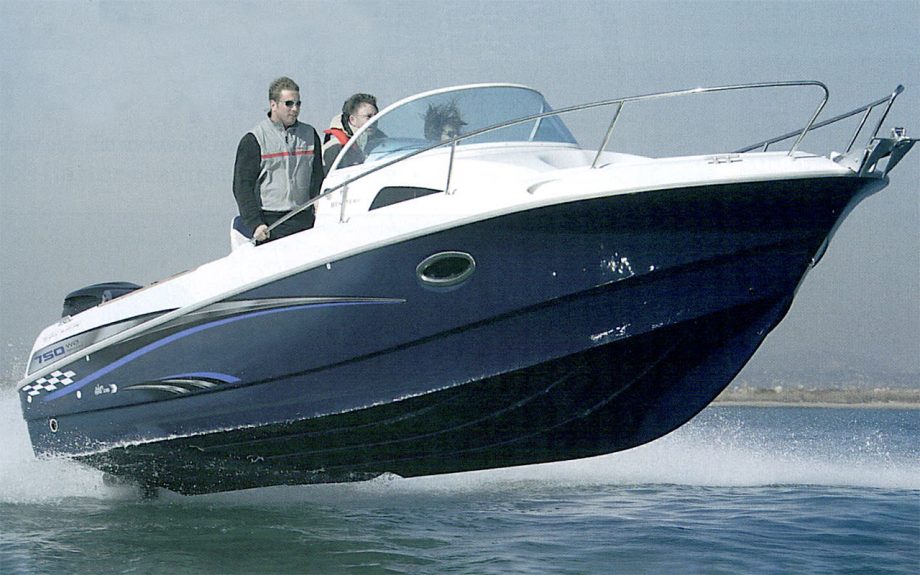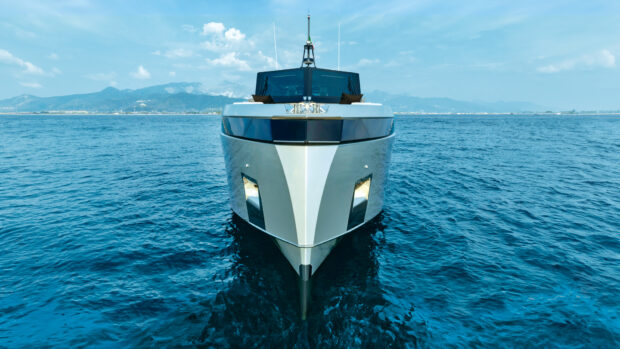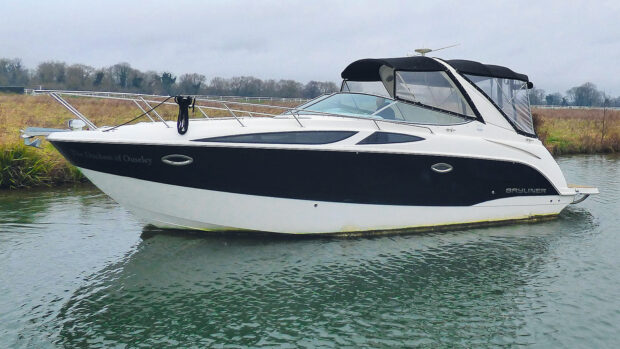Not all dayboats are out of the same homogenised mould. The Flyer 750 employs an innovative stepped-hull design to create a little boat with bags of attitude
Nowadays, there are scores of small dayboats to choose from, and plenty of good ones too. So what makes the Beneteau Flyer 750 so special that we have singled it out for an MBY test?
Its unusual and exceptional stepped hull, that’s what. Of course, stepped hulls are hardly pioneering news – the first patent was issued in 1908.
But Beneteau‘s interpretation is the only production boat we know of that uses such a novel arrangement. Just like an aircraft wing, a forward-facing step is intrinsically less dynamically stable than one facing aft.
Try flying a paper dart with forward-facing wings and you’ll discover why most aircraft wings still sweep aft from the fuselage.
However, this presents boat designers with a problem. To function at all, a step needs air flowing freely along its length to force the water to break free of the hull bottom.

Good dash layout includes handy pocket for odds and ends.
This air doesn’t mind entering the step’s opening at the chine and running aft towards the keel. Understandably though, it doesn’t like being asked to force its way forward, as it would have to if the step ran forwards from the chine to the keel.
To maximise the airflow along the step, most steps run straight across the hull or even slightly forward, in the opposite direction to that required for maximum dynamic stability. Beneteau’s innovative 750 uses an alternative solution.
Its steps run aft from the keel to the chine (oddly, Beneteau designate this ‘forward facing’, but ignore the anomaly) and the necessary air is force fed into the front end of the steps (over the keel) through ducting that runs down from vents in the superstructure.
In theory, the result is threefold: a more consistent supply of air along the step; the extra dynamic stability that comes from having an aft-facing step; and the ability to leave the chine unbroken.
The idea of force feeding steps with air is not new, but this is the first mainstream boat we have seen with this system.
Driving the Beneteau Flyer 750
Whether Beneteau’s solution works any better than the conventional alternative is impossible to say without a like-for-like comparison.
But that hardly matters because it is a great little hull – among the very best small-boat hulls I have driven.
Its ride is amazingly soft. Although we regularly had the Beneteau Flyer 750 airborne, courtesy of a metre-high swell and its 40.2-knot top speed, the landing was ever so gentle.
The archetypal stepped hull characteristic of a level ride and flight ensured that it landed flat rather than on its bum.
But the fine forward sections also helped considerably. In choppy conditions these produced a smoother upwind ride than the stepped-hull Nimbus Nova 250 or 300; its impressive ride was more in line with the slender boats that Windy build.
Certainly, the 750 feels dynamically very stable, and its stepped hull remains firmly planted however crazy your antics.
The wildest full-lock, high-speed turns can’t shake it free, even if you have the outboard trimmed up unnecessarily high.
The only significant evidence that this is not simply an exceptionally good conventional hull is the Beneteau Flyer 750’s level ride.
Its almost imperceptible transition onto the plane, and its insensitivity to outboard trim.

The folding foredeck covers on the WA convert the flush sunbed area into a cosy two-person seat.
It does respond to trimming a little, but the Beneteau Flyer 750 doesn’t mind if you get it wrong, and there’s no need to trim the engine to climb onto the plane. This is a very easy boat to drive.
You’d be crazy to plump for the twin outboard-powered boat. Modern engines are incredibly reliable nowadays, and the big single handles more sharply, it is cheaper to service.
And because you are only dragging one outboard leg through the water – far more fuel efficient. Our 250hp Suzuki propelled us over 40 knots, so their new 300hp outboard should see 44.
Also, forget the bucket seats and specify, the excellent leaning post instead – it works far better in this size of boat. And teak decks only cost £830, but look a million dollars on the Beneteau Flyer 750.
Above and below decks of the Beneteau Flyer 750
There are two versions: the 750 Open with its cuddy for odds and ends, and the oddly named 750 Walkaround
TThe Open version provides safe walkaround decks, whereas the WA version has conventional raised side decks.
The WA provides a bigger cuddy complete with separate heads, a double berth and a tiny galley.

Cuddy on WA can’t offer full standing headroom but is fine for overnighting.
It lacks full standing headroom, but you wouldn’t feel hard done by if all the local B&Bs were full.
Although the WA lacks the surprisingly large forward seating area of the Open, it has a canny folding foredeck cover that – hinges open to reveal a cosy two-person seating area.
With prices starting at £21,546 inc UK VAT for an engine-less boat, you can hardly expect luxury.
Nevertheless, the same methodical production engineering that goes into their £250,000 Swift Trawler 42 also finds its way into the 750, and the result is a very cleanly built boat with impressive mouldings, sound engineering and a fine finish.
The last word
The Beneteau Flyer 750 stands or falls on the success of its unusual stepped hull, which flies in the face of conventional practice.
Based on our two day test, which took in rolling swells and glassy cairn water, I’d rank it among the best I’ve tried. It is easy and forgiving to drive, efficient, controllable and heaps of fun – what more could you ask for?
First published in the May 2006 issue of MBY.
Details
Price from – Open: £35,249 inc UK VAT (single 250hp)
Price from – WA: £38,454 inc UK VAT (single 250hp)
Overall length: 23ft 8in (7.20m)
Hull length: 23ft 0in (7m) ex. Pulpit & platform
Beam: 8ft 3in (2.53m)
Displacement: 1.88 tonnes light, 2.12 tonnes loaded; (loaded= light + 100% fuel & water)
Draught: 2ft 8in (0.80m)
Air draught: 6ft 11in (2.10m)
Fuel capacity: 63 imp gal (285 litres)
Water capacity: None
RCD category: C (for 9 people)
Slow cruising: 24.9 knots, 153 miles@ 4,000rpm
Fast cruising: 33.6 knots, 147 miles@ 5,000rpm
Flat out: 40.2 knots, 107 miles@ 6,000rpm with 250hp
Test engines: Single 250hp Suzuki outboard; 250hp @ 5,500rpm to 6,100rpm; Twin 140hp Suzuki outboards; 140hp @ 5,600rpm to 6,200rpm; 300hp: maximum recommended horsepower
Contact: www.beneteau.com










